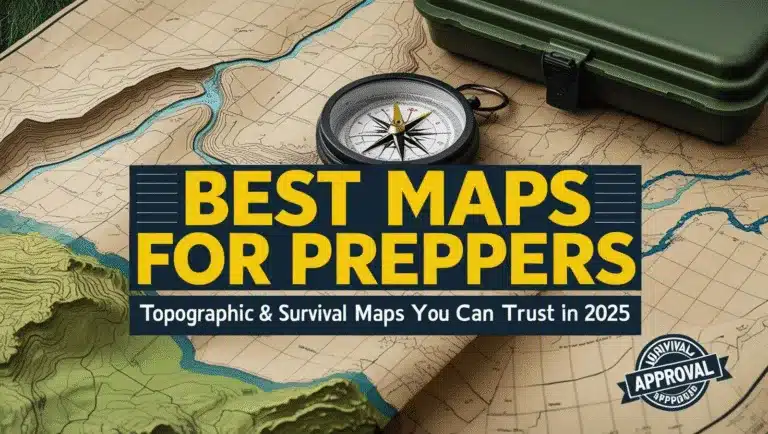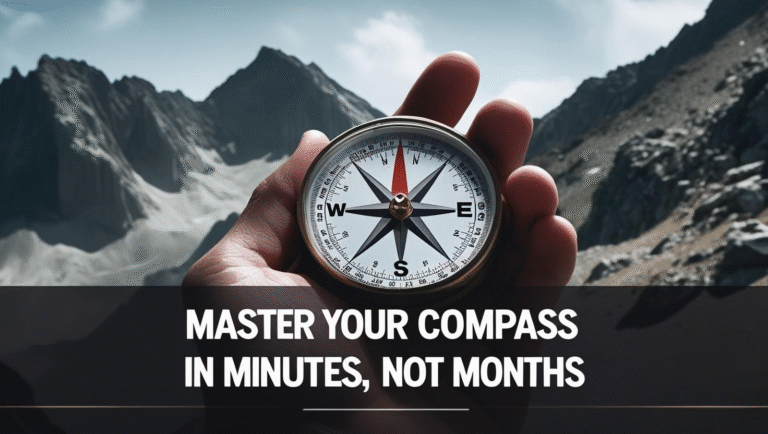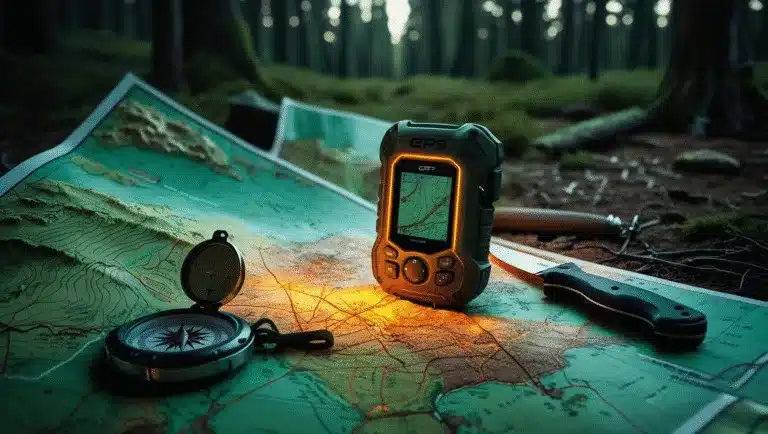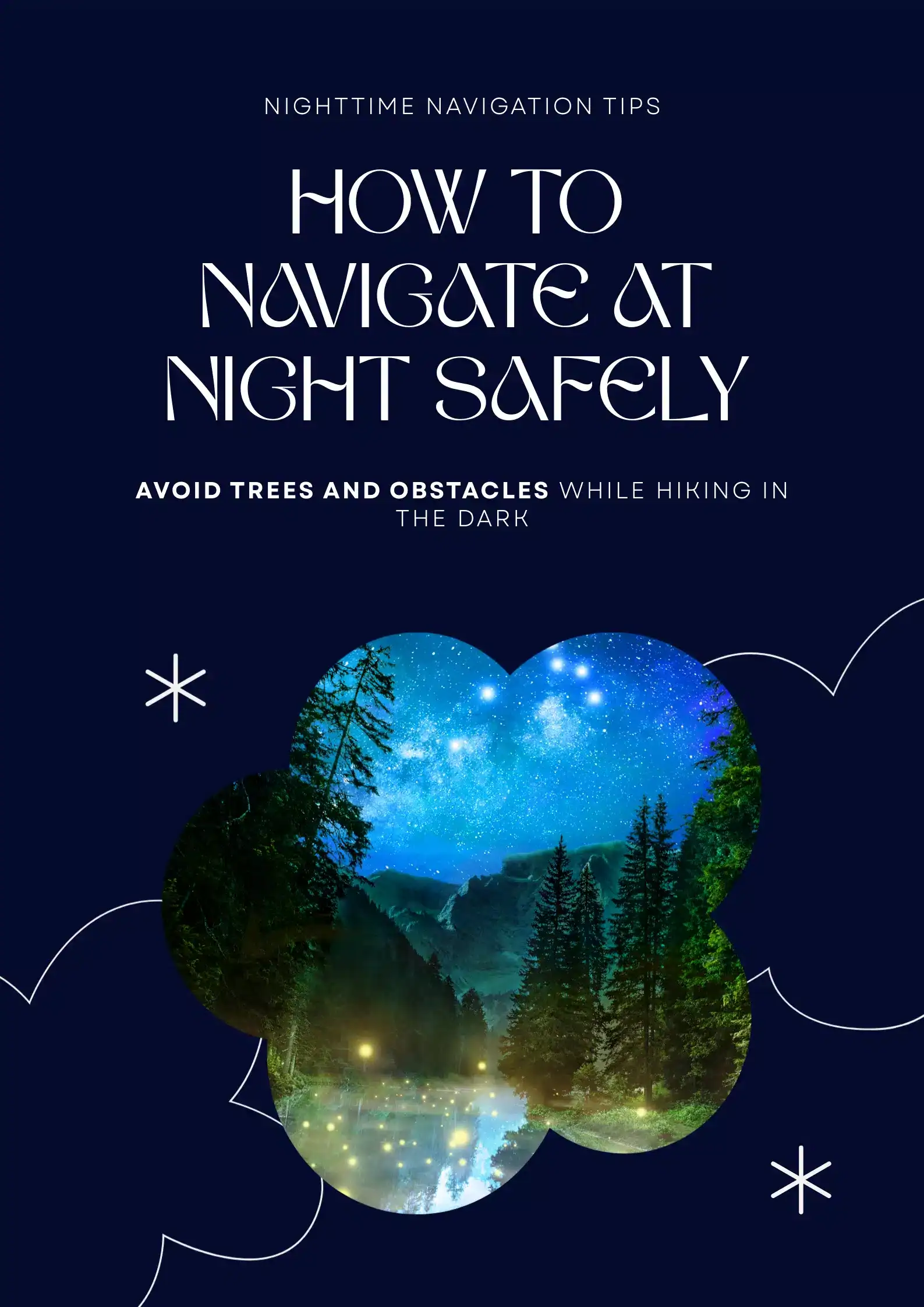
How To Navigate at Night Without Walking Into a Tree: A Comprehensive Guide for preppers and People Who Should Know Better
Navigating at night is a skill that transforms a daunting trek through the dark into a calculated, confident journey—or at least one where you don’t become a cautionary tale told around campfires. Whether you’re a hiker who miscalculated sunset times (again), a prepper stockpiling skills for the zombie apocalypse, or just someone who enjoys making their outdoor adventures unnecessarily difficult, night navigation is basically a requirement if you want to keep all your teeth and sanity intact!
This guide dives deep into the why, how, and “dear God what have I gotten myself into” (I have spoken this SO many times) of moving through the dark without becoming intimately acquainted with every tree trunk in a five-mile radius.
Why Night Navigation Matters: Because Murphy’s Law Doesn’t Sleep
The woods don’t sleep, and apparently, neither do your poor life choices. Daytime hiking is like navigation with training wheels—plenty of light, obvious landmarks, and the comforting illusion that you know what you’re doing. Night hiking is like playing the same game blindfolded while someone moves all the furniture around.
Here’s why mastering night navigation isn’t just a cool party trick:
Emergencies Don’t Wait for Dawn: Because apparently, twisted ankles, wildfires, and natural disasters have zero respect for your sleep schedule. That bear you’ve been avoiding? He doesn’t care that it’s 2 a.m. and you’re having an existential crisis about your life choices.
Preppers Plan for Every Scenario: If you’re one of those delightfully paranoid folks preparing for societal collapse (and honestly, good for you, I am right there with you), night navigation ensures you can bug out at any hour. Because when the grid goes down, you don’t want to be the person stumbling around in the dark like a drunk college student.
Confidence Breeds Survival: Knowing you can navigate in the dark reduces panic and prevents you from making spectacularly bad decisions. Panic makes you do stupid things like follow mysterious lights that definitely aren’t other hikers (spoiler alert: they’re usually not). Don’t ask me how I know about this!
Daytime Skills Get a Confidence Boost: If you can navigate by starlight with a compass that costs less than your morning latte, daytime trails will feel like cheating. You’ll be that insufferably competent person everyone secretly envies.
Bragging Rights: Because nothing says “I have my life together” like casually mentioning you hiked out at midnight without dying. Your friends will either be impressed or concerned about your mental health. Probably both.
Night navigation isn’t just a skill—it’s insurance against your own questionable judgment and Mother Nature’s twisted sense of humor.
The Art of Learning to Navigate at Night (AKA Expert Mode for People Who Think Day Hiking Is Too Easy)
Night navigation is the process of orienting and moving through terrain when you can’t see jack squat. It combines natural cues (that you’ll probably miss), tools (that you’ll forget to bring), and techniques (that sound easier than they are) to keep you moving in roughly the right direction.
Think of it as regular navigation after someone turned the difficulty setting to “sadistic.” Fewer visual cues, higher stakes, and trees that seem to have developed a personal vendetta against your shins.
Unlike daytime navigation, where you can wing it and rely on “that looks about right,” night navigation demands precision, preparation, and the patience of a saint. It’s not about speed—it’s about not becoming a missing person statistic.
Step-by-Step Guide to Navigate at Night: How to Move Like Someone Who Actually Planned Ahead
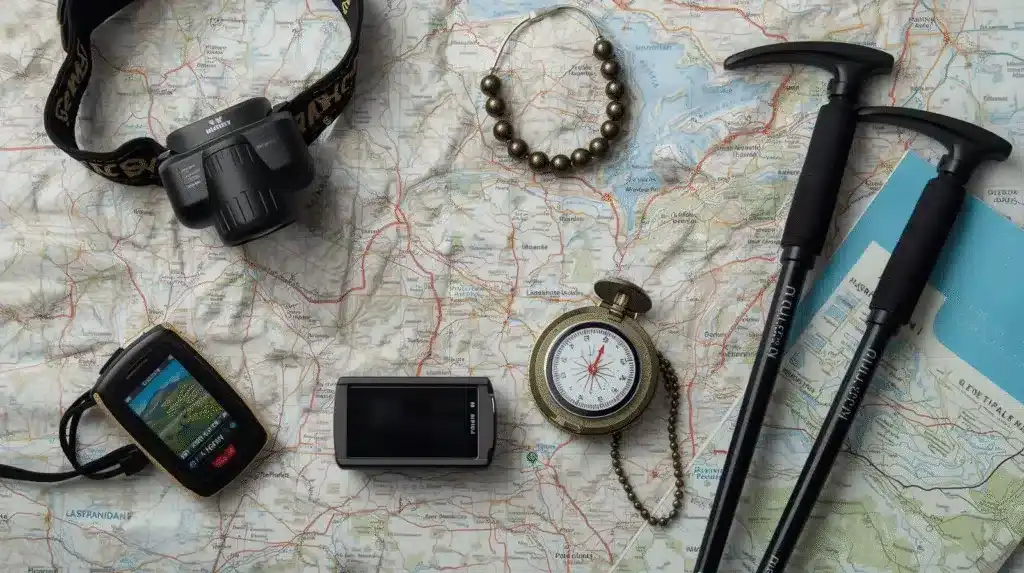
Step 1: Gear Up Like Your Life Depends on It (Because It Might)
Your gear is your lifeline in the dark, assuming you actually remembered to pack it and the batteries aren’t dead. A poorly equipped night navigator is basically just expensive wildlife entertainment.
Headlamp with Red Light Mode: Red light preserves your night vision, which turns out to be pretty important when you’re trying not to walk off a cliff. Get something with at least 200 lumens, because “barely adequate” isn’t a lighting strategy. Recommendation: Olight Perun 2 Mini Headlamp – because stumbling around with a dying Walmart flashlight isn’t a personality trait.
Glow-in-the-Dark Compass: A compass with luminescent markings means you won’t have to choose between seeing where you’re going and knowing which direction that is. Recommendation: Suunto MC-2G Compass – global needle, glow-in-the-dark bezel, and built for people who actually use them.
Tactile Map Case: A map you can handle without dropping it into the nearest stream. Waterproof cases with grid markings are your friend, unlike that “friend” who suggested this hike in the first place.
Backup Flashlight: Because Murphy’s Law absolutely loves dead batteries, especially at the worst possible moment. Pack a lightweight backup with fresh batteries, you optimistic fool.
Trekking Poles: These double as “tree detectors,” helping you discover obstacles before they discover your face. Think of them as insurance for your dignity.
Ranger Beads (Pace Counter): A beautifully simple, low-tech tool for tracking distance. Cheap, reliable, and impossible to forget to charge because it doesn’t need charging.
GPS (Optional but Sensible): A rugged GPS unit like the Garmin GPSMAP 67i can save your bacon when your superior navigation skills meet reality. But don’t rely on it exclusively—technology has a cruel sense of timing.
Pro Tip: Test your gear in daylight first, because 2 a.m. on a mountain is not the time to discover you don’t know how your headlamp works.
Step 2: Train Your Eyes to Navigate at Night (They’re Not as Smart As You Think)
Your eyes are basically biological night-vision goggles, if night-vision goggles were designed by someone with a questionable understanding of user experience:
Give Your Eyes 15–30 Minutes to Adjust: After staring at your phone like a civilized human, your eyes need time to remember how to work in actual darkness. Rod cells take about 20 minutes to stop being completely useless.
Avoid White Light Like It’s Your Ex: One blast of white light from your phone resets all that patience you just invested in your night vision. Stick to red light or accept that you’re basically starting over.
Practice Peripheral Vision: Your rod cells live at the edges of your retina, which means the whole “look directly at things” approach doesn’t work so well. Look slightly off-center to actually see stuff, which feels as backward as it sounds.
Field Hack: Cover one eye when using white light. This preserves night vision in one eye, letting you switch back to darkness without completely starting over. You’ll look like a pirate, but a prepared pirate.
Step 3: Let the Land Guide You—Because Fighting Nature Is Exhausting
The terrain is your silent navigation partner, assuming you’re smart enough to listen:
Handrails: Linear features you can follow without constantly second-guessing your compass. Streams, ridgelines, trails, or fence lines all work. Think of them as nature’s GPS, but without the annoying voice telling you to make U-turns.
Catching Features: Obvious landmarks that basically yell “Hey dummy, you’ve gone too far!” Roads, lakes, or steep hills make excellent catching features. It’s like having a safety net, but made of geography.
Backstops: Barriers that prevent you from wandering into the next county. Cliffs and highways are great backstops, though for very different reasons.
Example: Heading to a ridge at night? Follow a trail (handrail), and remember that the valley beyond (catching feature) means you overshot. It’s like bowling with bumpers, but with more trees.
Step 4: Master Pace Counting and Bearings (Math You Actually Need)
Precision matters when you can’t see where you’re going:
Pace Counting: Figure out how many steps cover 100 meters in daylight (usually 60–70 double steps for normal-sized humans). At night, add 10–15% because you’ll be moving like a cautious grandparent. Use ranger beads to track progress—slide a bead, reset your count, try not to lose your mind.
Bearings: Your compass tells the truth even when your brain doesn’t. Take a bearing from your map before you start, then trust it more than your instincts. At night, your brain becomes a creative storyteller, turning shadows into trails and trees into cliffs.
Declination Adjustment: Account for magnetic declination because magnetic north and true north aren’t the same thing, because of course they’re not. Check your map’s declination diagram and adjust accordingly.
Pro Tip: Practice pace counting somewhere safe and boring. Your backyard works great and has fewer opportunities for dramatic failure.
Step 5: Move Smart—Embrace Your Inner Turtle
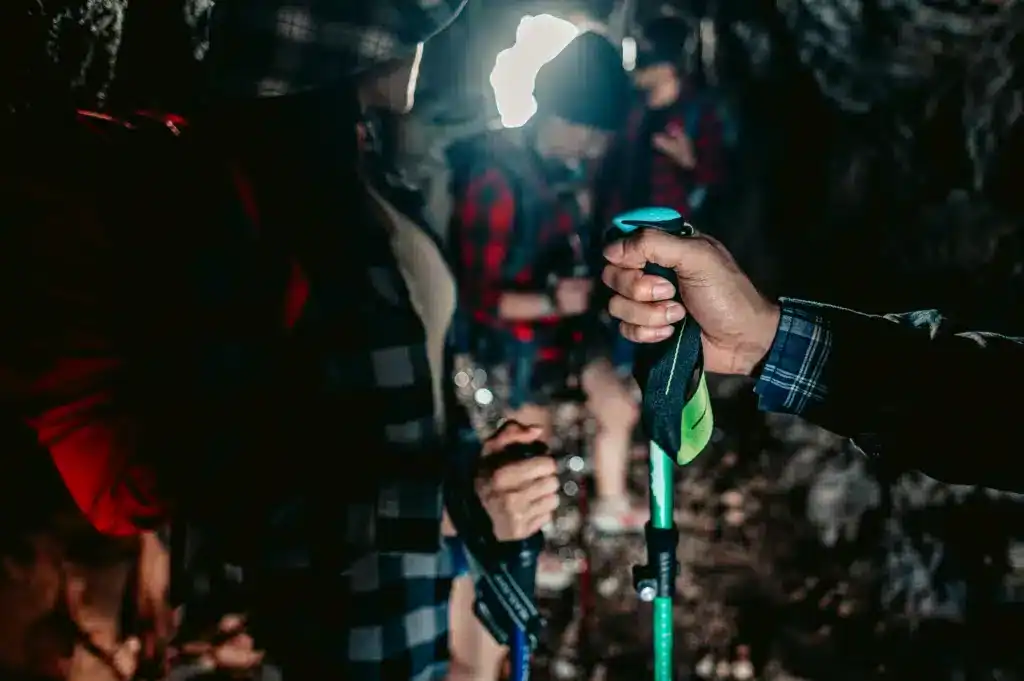
Night navigation rewards patience, not whatever that thing is you call confidence:
Shorten Your Stride: Smaller steps mean fewer face-plants and better pace counting. Save the power walking for when you can actually see obstacles.
Use Those Trekking Poles: They’re not just expensive hiking accessories—they actually detect roots and rocks before you trip over them. Revolutionary concept.
Stay Low-Tech: GPS is wonderful until it isn’t. Batteries die at the worst moments, and screens turn you into a glowing target for every bug in the forest. Compass and map are your primary tools, like it’s 1985 or something.
Pause and Listen: Stop every 10–15 minutes to figure out where the hell you are. Sounds like running water or distant traffic can confirm your position or at least tell you you’re not completely lost.
Mark Your Path: Use subtle markers to track your route, but try not to destroy the environment while you’re at it. Future hikers will judge you.
Navigation Mantra: Slow is smooth, smooth is fast, and fast face-plants into trees.
Step 6: Celestial Navigation Basics (For When Technology Abandons You)
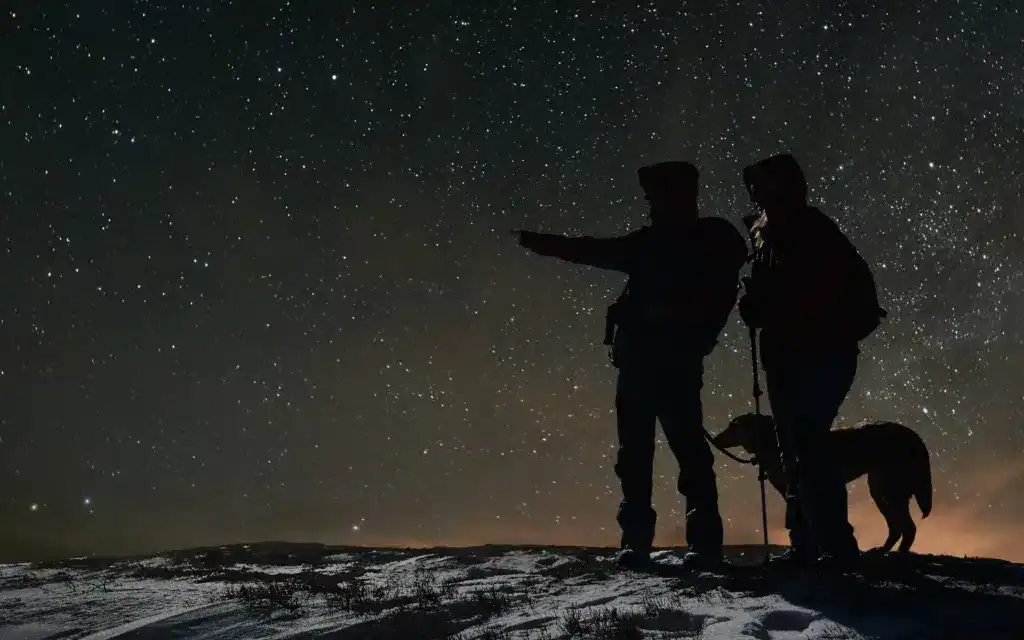
When batteries die and clouds hide the moon, the stars become your backup plan:
Find Polaris (North Star): In the Northern Hemisphere, find the Big Dipper. Draw an imaginary line through the two stars at the end of the “bowl” and extend it about five times to find Polaris. This is true north, assuming you can actually identify the Big Dipper in the first place.
Southern Hemisphere: Use the Southern Cross to find south, which is great if you happen to be hiking in Australia instead of Arkansas.
Moon Navigation: A crescent moon’s “horns” point roughly east or west depending on the time. It’s not GPS-precise, but it beats wandering in circles.
Practice Tip: Download a star chart app and practice in your backyard where the stakes are low and the bathroom is close.
Step 7: The Buddy System (Because Misery Loves Company)
Navigating alone at night is like playing Russian roulette with trees:
Bring a Partner: Two people means twice the chance someone knows what they’re doing. Assign roles—one person handles the compass, the other watches for branches that want to rearrange your face.
Communicate Your Plan: Tell someone your route and when you should be back. If you don’t check in, they’ll know where to start looking for your remains.
Know When to Quit: If conditions get bad enough, admit defeat and wait for dawn. A bivvy sack and your wounded pride will keep you warm until sunrise.
Key Considerations When You Navigate at Night (The Fine Print)
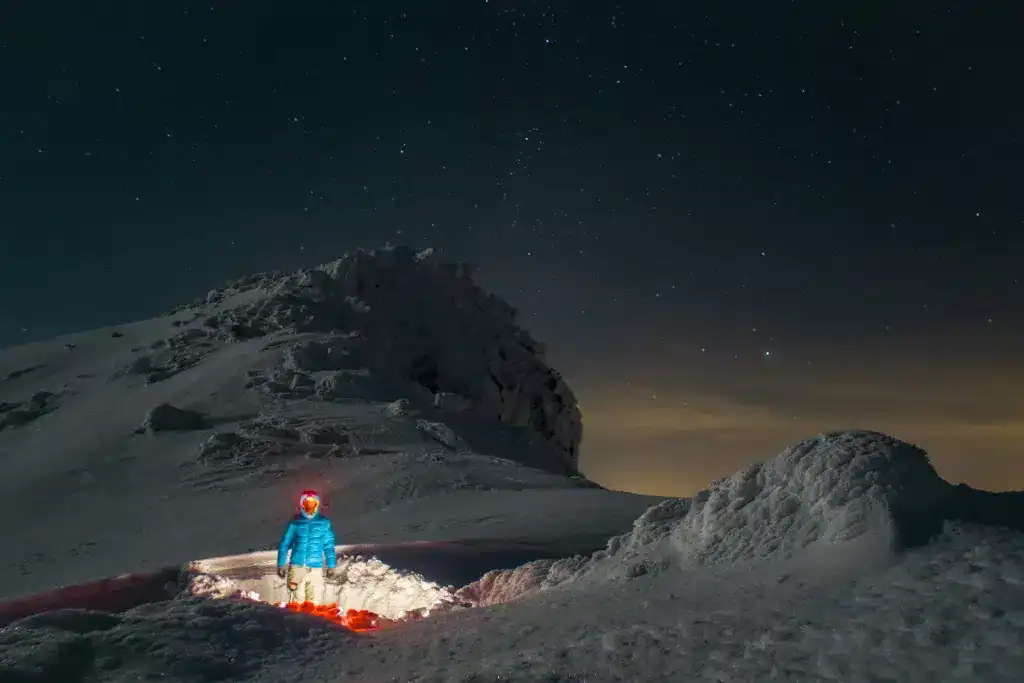
Weather Makes Everything Worse: Fog, rain, and clouds turn difficult navigation into a nightmare. Check forecasts unless you enjoy additional challenges.
Terrain Complexity: Dense forests and featureless deserts are harder at night. Start with easier terrain unless you’re a glutton for punishment.
Fatigue Amplifies Stupidity: Darkness makes you tired, and tired people make spectacularly bad decisions. Take breaks, stay hydrated, and eat something other than trail mix and regret.
Legal Restrictions: Some places restrict night hiking, probably because they’ve dealt with people like you before. Check regulations to avoid awkward conversations with park rangers.
Alternatives to Night Navigation (For the Sensible Among Us)
If night navigation sounds like more adventure than you bargained for:
Wait for Dawn: Set up camp and move when you can actually see. Revolutionary concept, but it works. Carry an emergency shelter for unexpected stops.
Practice During the Day: Build confidence when the stakes are lower and the trees are visible.
Join a Group: Learn from people who’ve already made all the mistakes you’re planning to make.
My Experience: A Masterclass in Humility (Arkansas Edition)
I learned night navigation the hard way on a ridgeline in Arkansas, because apparently I thought I was smarter than the sun. Plus, all good stories start this way. When darkness fell faster than my confidence, I found myself with a dying headlamp and a few spare batteries that were dead. Next time I will remember to check on them before a night excursion takes place.
After intimate encounters with three trees (and disturbing one very judgmental owl), I finally slowed down, found a stream to follow, and paced my way to safety like I should have done hours earlier, but I am hard headed and stubborn at times. The lesson? Night navigation demands humility, not bravado. Respect the dark, or it’ll humble you in ways you didn’t know were possible.
Wrapping Up: How to Navigate at Night With Confidence (and Fewer Bruises)
Night navigation isn’t about being fearless—it’s about being methodical, prepared, and adaptable. With the right gear, techniques, and a healthy dose of respect for things that can kill you, you’ll move through the dark with quiet confidence instead of loud panic and countless cuss words that would make even us former sailors blush.
Master this skill, and you’ll be ready for whatever the wilderness throws at you, day or night. Just try not to be too insufferable about it afterward.
FAQs About How to Navigate at Night
Q: What’s the best way to navigate at night without GPS?
A: Stick to a compass and map as your primary tools. GPS dies, compasses don’t. Use handrails, pace counting, and catching features to stay on track.
Q: Can I just use my phone flashlight to navigate at night?
A: You could—if you enjoy dead batteries and ruined night vision. A headlamp with red light mode is far better for preserving your eyes (and your dignity).
Q: Is learning to navigate at night only for military or SAR types?
A: Not at all. Anyone who hikes, camps, or preps benefits from this skill. The dark doesn’t discriminate—why should your training?
Q: How do I safely practice navigating at night?
A: Start small—backyard, local park, or a trail you know well. Add complexity slowly. Always bring a buddy until you’re confident.
Q: What should I do if I get completely lost while trying to navigate at night?
A: Stop. Breathe. Retrace your steps if possible. If not, stay put until dawn. Panicking makes things worse—and the trees aren’t going anywhere.
Related Guides for Further Learning
- Understanding Magnetic Azimuths: Because precision matters when you can’t see
- Best Maps for Preppers in 2025: Paper maps that won’t abandon you when you need them most
- Navigating Without a Compass: Old-school skills for when technology fails spectacularly
Heads-Up, Fellow Preppers:
Some links in this post are sponsored or affiliate links. If you click and buy, I may earn a small commission—enough to restock my peanut butter and maybe add one more can of chili to the stash. I only recommend gear I trust, use, and would hide in a bug-out bag.




